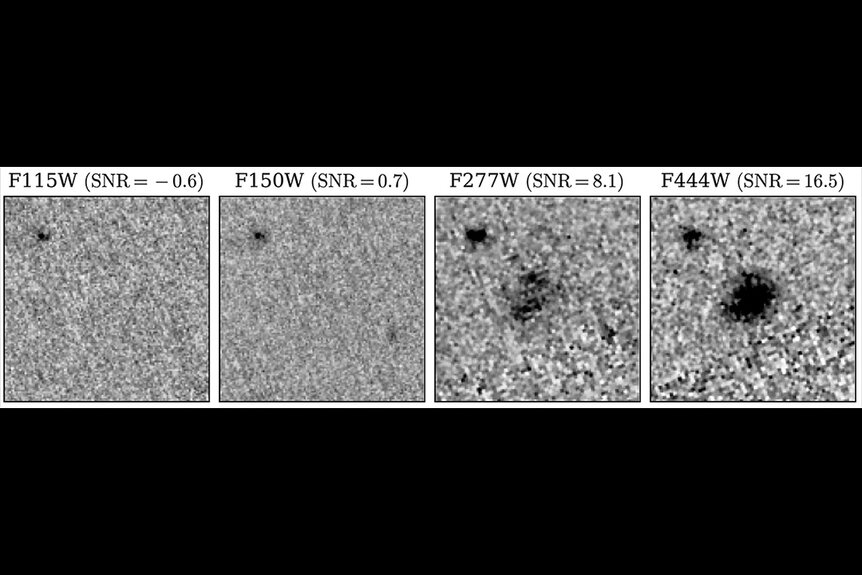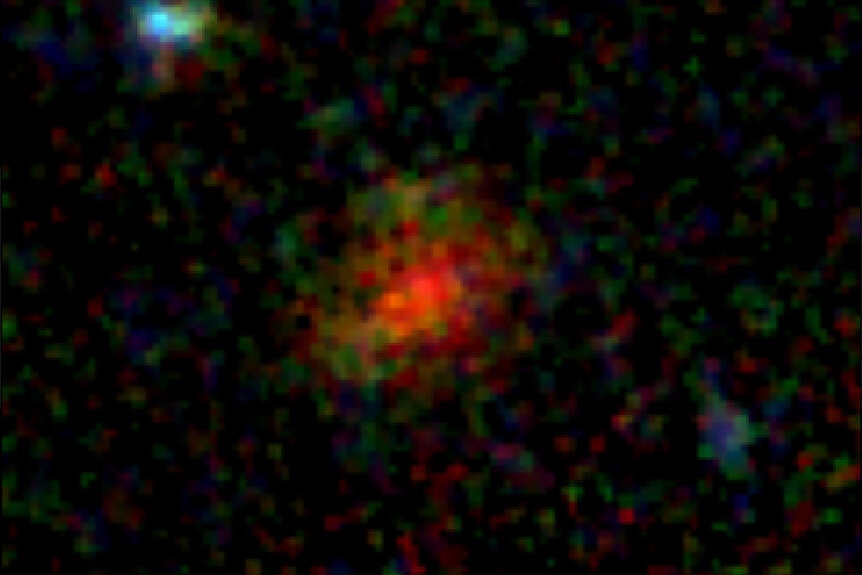Create a free profile to get unlimited access to exclusive videos, sweepstakes, and more!
JWST Finds Elusive Ghostly Galaxy in New Deep Space Images
Peek-a-BOO!

When Leigh Whannell reimagined The Invisible Man (streaming now on Peacock) he had to do it with modern technologies in mind. Instead of a vague chemical potion, Adrian Griffin (Oliver Jackson-Cohen) uses an advanced optical suit to render himself invisible. His tortured ex, Cecilia Kass (Elizabeth Moss) is painfully unable to see him, even when she knows he’s there.
Over the last couple of years astronomers have been locked in a similar if slightly less dramatic optical game of cat and mouse with a disappearing galaxy. Now, new observations from the James Webb Space Telescope (JWST) confirm the galaxy’s existence and reveal new details.
JWST Captures an Elusive Ghostly Galaxy in the Early Universe
The ghostly galaxy AzTECC71 was first glimpsed by the James Clerk Maxwell Telescope in Hawaii, which glimpses the sky at wavelengths between the infrared and microwave parts of the spectrum where human eyes are basically worthless. It was later picked up by the ALMA telescope in Chile, which searches in the infrared. But when astronomers tried to get a closer look with Hubble – the Hubble Space Telescope can see a little way into the infrared and the UV but is largely an optical telescope soaking up visible light – the galaxy vanished from view.
RELATED: Hubble and JWST Join Forces to Create Most Colorful View of the Cosmos Ever
Astronomers were awarded 250 hours of telescope time during JWST’s first year of operation to check out AzTECC71, among other things. The first batch of data has been received with more expected in early 2024. The observations are part of the COSMOS-Web project which intends to map up to a million galaxies within a relatively small patch of the sky, about the same size as three full Moons.
Using JWST, astronomers scoped out AzTECC71 at a number of different wavelengths. In some of the images the galaxy is clearly visible (we recognize the weirdness of using that word for invisible light) while in others it can’t be seen at all. This seemingly weird behavior can be explained by a dense cloud of gas and dust. Astronomers suggest we are looking at a dusty star-forming galaxy busily cranking out new stars from behind a veil of gas and dust, in a new study published in the Astrophysical Journal.
Based on its redshift, the galaxy is estimated to have formed less than a billion years after the Big Bang which makes it particularly interesting. These sorts of galaxies were thought to be rare in the early universe but this discovery along with a dozen other candidate galaxies suggest they might be more common than we thought.
“This thing is a real monster. Even though it looks like a little blob, it’s actually forming hundreds of new stars every year. And the fact that even something that extreme is barely visible in the most sensitive imaging from our newest telescope is so exciting to me. It’s potentially telling us there’s a whole population of galaxies that have been hiding from us,” said Jed McKinney, lead author of the study, in a statement.
AzTECC71 is invisible to us because the light from its stars is being blocked by a thick cloud shell. When visible light from the galaxy hits the dust, it gets absorbed and never gets a chance to reach us. However, there’s no such thing as a perfect wall and the light makes its way through eventually. Visible light absorbed by dust gets re-emitted as infrared light which we can’t see, but JWST can.
“With JWST, we can study for the first time the optical and infrared properties of this heavily dust-obscured, hidden population of galaxies,” McKinney said, “because it’s so sensitive that not only can it stare back into the farthest reaches of the universe, but it can also pierce the thickest of dusty veils.”
When you’re looking for something invisible, whether it’s a galaxy or your allegedly deceased ex-boyfriend, knowing how to look is just as important as knowing where to look. You can catch The Invisible Man right now, streaming on Peacock.




























